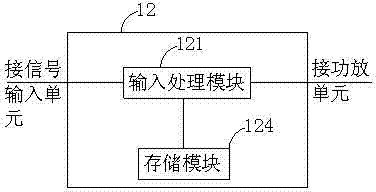Active sound box and speaker system calibration method
A speaker and sound box technology, applied in electrical components and other directions, can solve the problems of inability to guarantee the acoustic effect, large time workload, and difficulty in predicting the sound box, etc., to optimize the overall acoustic effect, and reduce the difficulty and workload.
- Summary
- Abstract
- Description
- Claims
- Application Information
AI Technical Summary
Problems solved by technology
Method used
Image
Examples
Embodiment 1
[0036] Such as figure 1 As shown, the active speaker in this embodiment includes a signal input unit 11 , a digital signal processor 12 , a power amplifier unit 13 and a speaker unit 14 . The signal input unit 11 is used to receive the audio signal input from the speaker and transmit it to the digital signal processor 12 .
[0037] Such as figure 2As shown, the digital signal processor 12 is provided with a data storage module 124, and a set of input processing parameters is stored in the data storage module 124. The set of input processing parameters includes a plurality of entity DSP data, and the types of entity DSP data are not limited. The input processing parameters may include multiple physical DSP data of the same type, or multiple different physical DSP data. Each entity DSP data contains a speaker layer DSP parameter corresponding to the type of the entity DSP data, and the speaker layer DSP parameter is a DSP parameter set for the active speaker; and at least one...
Embodiment 2
[0059] The difference between this embodiment and Embodiment 1 is that in the active speaker of this embodiment, among the various entity DSP data included in the input processing parameters, the entity DSP data that contains the array layer DSP parameters also includes a corresponding speaker layer DSP parameter System layer DSP parameters of the same type, the system layer DSP parameters are set for each speaker member of the system group to which the active speaker belongs, and the system group includes one or more active speakers.
[0060] The DSP parameters (which may be any type of DSP parameters) used to simultaneously adjust the characteristics of the speaker members of the system group are called system layer DSP parameters, that is, each speaker member of the same system group shares the data of the system layer DSP parameters. If a system layer DSP parameter of a certain speaker member in the system group is modified, the corresponding system layer DSP parameters of ...
Embodiment 3
[0065] The difference between this embodiment and Embodiment 1 is that: in the entity DSP data included in the input processing parameters of the active speaker in this embodiment, at least one entity DSP data also includes a system layer DSP with the same type of speaker layer DSP parameter parameter, the system layer DSP parameter is set for each speaker member of the system group to which the active speaker belongs, and the system group includes one or more active speakers.
PUM
 Login to View More
Login to View More Abstract
Description
Claims
Application Information
 Login to View More
Login to View More - R&D
- Intellectual Property
- Life Sciences
- Materials
- Tech Scout
- Unparalleled Data Quality
- Higher Quality Content
- 60% Fewer Hallucinations
Browse by: Latest US Patents, China's latest patents, Technical Efficacy Thesaurus, Application Domain, Technology Topic, Popular Technical Reports.
© 2025 PatSnap. All rights reserved.Legal|Privacy policy|Modern Slavery Act Transparency Statement|Sitemap|About US| Contact US: help@patsnap.com



